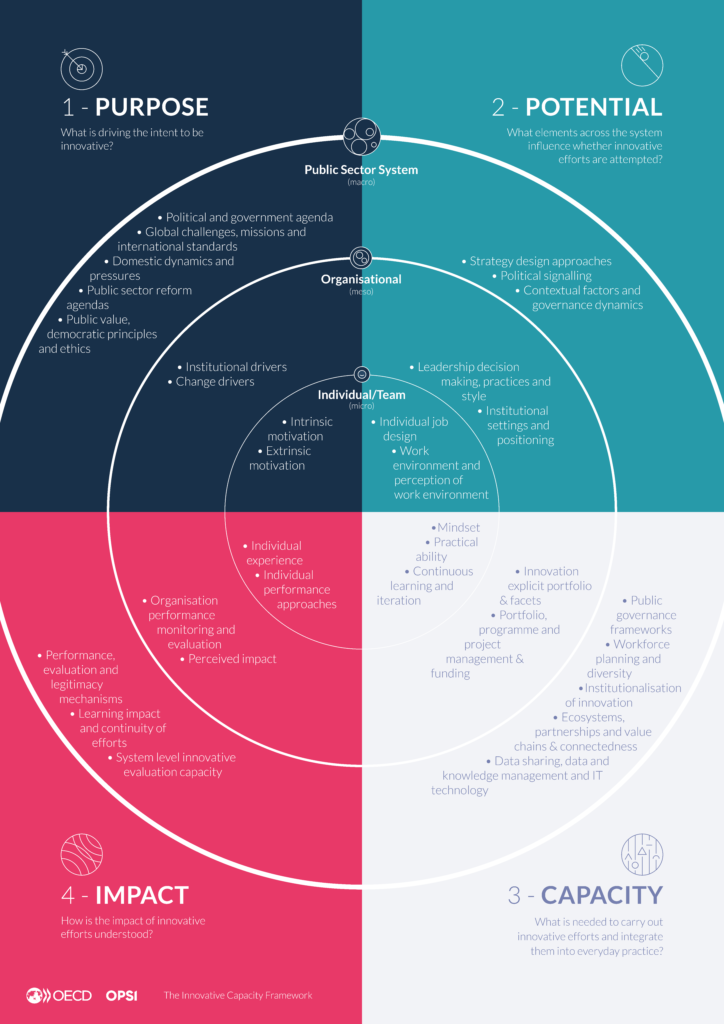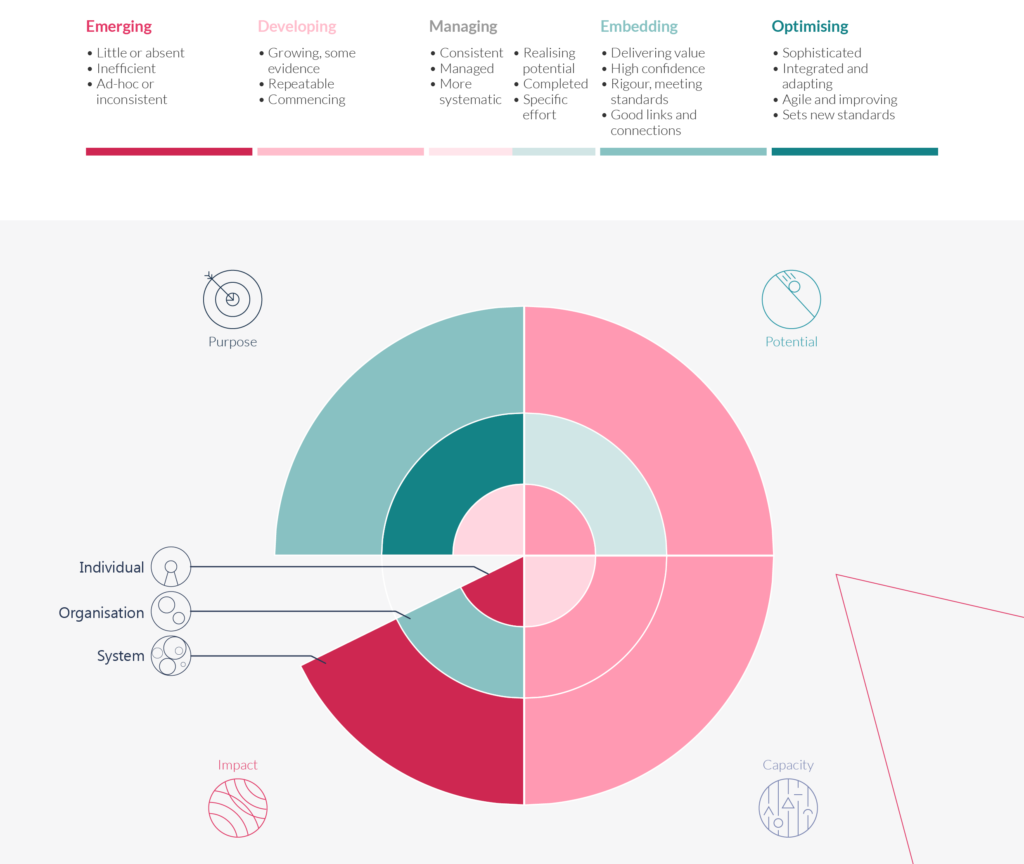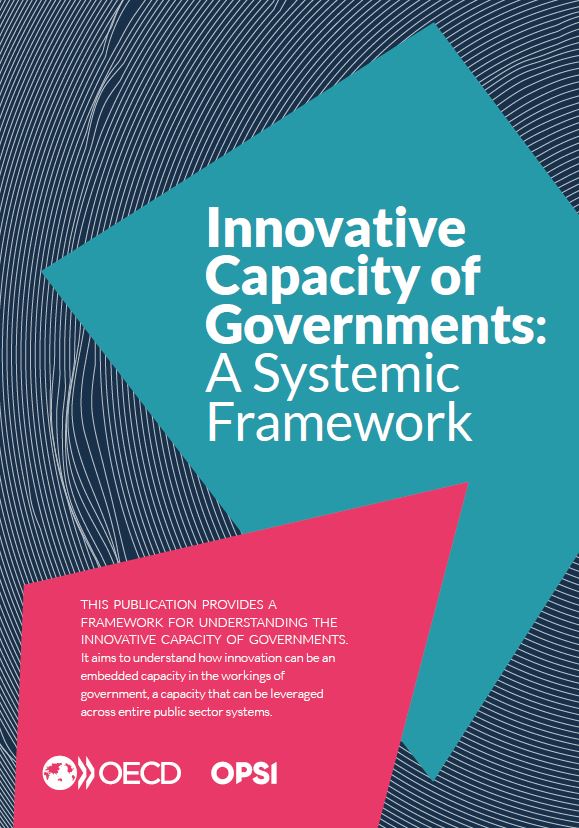Innovative Capacity of Governments: A Systemic Framework

Executive summary
Given the increased complexity of the world and emergence of wicked problems faced by governments including climate change, infectious diseases and rapid technological advances, enhancing the innovative capacity of governments and public sector systems has become an imperative. It’s not enough for governments to maintain the status quo or innovate only when forced by crises. Governments need to proactively engage with the future, explore the potential of innovative approaches and solutions and work towards the constant improvement of the lives of all.
To assist governments in understanding and harnessing their innovative capacity, OPSI developed the Innovative Capacity Framework. This practical and systemic Framework guides governments in leveraging innovation as an integral part of policymaking and administration and supports them to enhance their capacity to proactively adapt to the changing environment. Ultimately, the Framework helps governments steward their public administration systems to build more holistic, impactful and sustainable solutions and improve the lives of citizens.
For innovative capacity to flourish, we need to move away from innovation as a sporadic activity, fuelled predominantly by crises, to systemically embedding innovation at the heart of policymaking and public administration.
Innovative Capacity: The Framework
For innovative capacity to move beyond niche pockets and towards a strategic tool that is cultivated and leveraged across the entire government system, intentional and systemic capacity needs to be built. This requires governing mechanisms that drive innovative efforts (purpose), creating an enabling culture and space for innovative efforts (potential), ensuring the integration of the right skills and resources for innovation into the rules, practices and workforce (capacity) and understanding and learning from innovative efforts (impact). Innovative capacity is crucial for governments to design and deliver ambitious reform agendas, meet climate targets, respond to global crises and shape better futures. Without a deliberate understanding and effort, the dynamics of the public sector system will continue to push forward the status quo operating methods.
The Framework showcases the need for innovation explicit supports that aim to aim to legitimise and enable the management of innovation (e.g. innovation strategy, training, awards, networks, hubs or labs) alongside innovation implicit supports aimed at shaping broader governing mechanisms to enable and steer the public sector to use innovative approaches within the public governance system (e.g. working with audit, performance management, regulatory frameworks among others).
Frames of focus
To better understand innovative capacity, this Framework explores key drivers, enablers, barriers, capacities and impacts through four key questions:
Purpose: What is driving the intent to innovate?
In a historically-shaped, path-dependent public sector context, innovation is unlikely to surface in a consistent manner unless there are clear motivations and drivers for innovation. Drivers of innovation can come from global shocks and crises, but they can also include deliberate mechanisms to motivate organisations (ex. organisational mandate that clearly signals the need to innovate) or individuals to innovate (ex. recognition/awards for innovative activity).
Potential: What elements across the system influence whether innovative efforts are attempted?
While there may be a clear driver for innovation, and perhaps even the skills and capacities for it to take shape, there are a number of barriers that can prevent innovative efforts from being attempted. A common barrier is the perceived system culture: at times, actors feel that they don’t have the autonomy, ownership or opportunities to try new things, take risks and experiment. Creating potential for innovative capacity could take the form of clear leadership direction in support of innovation, normalisation of risk and creativity and deliberate efforts to support experimentation.
Capacity: What is needed to carry out innovative efforts?
Leveraging innovative approaches requires creative mindsets, practical abilities and deliberate supports for innovative capacity. Innovating needs to be integrated into the everyday practices, rules and culture of the public sector system and be embedded into its governing mechanisms. This can include building skills in innovation portfolio management, behavioural insights, systems thinking and foresight, supported by flexible procurement and funding mechanisms as well as regulatory rules and contemporary and agile project management approaches and mechanisms to engage across sectors.
Impact: How is the impact of efforts understood and informing future practice?
Investments in implicit and explicit innovative efforts need to demonstrate value and impact to help inform and justify future decision-making and investments. Governments need to develop learning loops, evaluation practices and skillsets to understand the impacts of projects and initiatives, measure the gaps in innovative capacity, and inform future practice and business cases. In addition, contemporary, systemic and impact-based evaluative approaches need to consider how innovative efforts link to broader policymaking and public administration efforts.

Innovative capacity: Influencing factors
The Framework guides the exploration and reflection of different dynamics within a system (which can be tailored to a whole public sector system, a policy sector or a policy-making system). Given public sector systems require consideration of all elements and actors and their interactions, the Framework supports focus at three levels: individuals and teams, organisational and whole of system through four lenses (purpose, potential, capacity and impact).


The Innovative Capacity of Governments: A Systemic Framework
Published on 1 April 2022.
The Innovative Capacity Framework aims at highlight key focus areas for building and understanding innovation capacity. It also showcases how innovation needs to be embedded and interact with the entire public administration and governing system, including how it interacts, is understood and is influenced by drivers, factors, capacities and supports across the system.
